Botanica Pacifica: a journal of plant science and conservation. Botanica pacifica журнал
Botanica Pacifica: a journal of plant science and conservation (@geobotanica)
Статьи журнала

A topography-based model of the vegetation cover of the Lanzhinskie mountains
Omelko Alexander M., Krestov Pavel V., Yakovleva Anna N.
Статья научная
By means of the GAM technique it is possible to create detailed maps of the potential vegetation for regions that are difficult to access. This is particularly important for wide mountain areas of Northeast Asia, where such maps have never been created. High-resolution DEMs permit increased prediction accuracy and modeling of complex vegetation patterns. Most vegetation types in the area are controlled mainly by the moisture regime and by regimes of sediment transport and accumulation. The relatively small amounts of rainfall in the continental climate are distributed spatially by relief elements. This creates a wide range of soil moisture regimes: from very dry, with a prolonged period of moisture deficit, to wet, without moisture deficit during the growing season at all. Therefore, moisture appears to be a critical resource in this climatic region, and it is a main differentiating factor for the vegetation. The map of potential vegetation, obtained satisfactorily, reflects altitudinal zonation and inter-zonal patterns of vegetation distribution. The area occupied by some vegetation communities is overestimated, however, due mainly to insufficient DEM resolution.
Бесплатно

Chromosome numbers for vascular plant from Sakhalin, Moneron and the Kuril Islands (North-East Asia)
Probatova Nina S., Barkalov Vyacheslav Yu., Rudyka Elvira G.
Статья научная
Chromosome counts were made for 34 plant species from Sakhalin, Moneron and the Kuril Islands, including: 9 species of Brassicaceae, 6 species of Asteraceae, 5 species of Poaceae, 4 species of Rosaceae, 3 species of Polygonaceae, 2 species of Caryophyllaceae and one each for Araceae, Ericaceae, Fabaceae, Hemerocallidaceae, Ranunculaceae. First chromosome information for Pulsatilla taraoi (Makino) Takeda ex Zam. et Paegle and Arctopoa alexeji (Sofeikova et Worosch.) Probat. is given. New cytotypes for Artemisia montana (Nakai) Pamp., Taraxacum shikotanense Kitam., Draba sachalinensis (Fr. Schmidt) Trautv. were revealed. Festuca hondoensis, Silene dichotoma Ehrh., Artemisia montana were studied in Russia for the first time. For some species from the Kurils first chromosome data are obtained.
Бесплатно
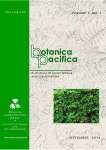
Chromosome numbers of some vascular plant species from the South Baikal Siberia
Chepinoga Victor V., Gnutikov Aleksandr A., Lubogoschinsky Pavel I.
Статья научная
Chromosome numbers for 22 vascular plant species from Baikal Siberia are reported. The four species (Asparagus brachyphyllus Turcz., Lupinaster popovii Roskov, Primula serrata Georgi, Galium paradoxum Maxim.) are studied caryologically for the first time. Also the new cytotypes in Asparagus davuricus Fisch. ex Link and Myriophyllum verticillatum L. were revealed. For 7 species there are first chromosome counts in Siberia.
Бесплатно

The hierarchy and combinatorial space of characters in evolutionary systematics
Vasilyeva Larissa N., Stephenson Steven L.
Статья научная
The Linnaean hierarchy is discussed as the taxonomic model for the evolutionary differentiation of the earth's biota. Careful examination of this model allows us to understand a number of ideas relating to evolutionary theory. The arguments about species constancy vs species variability, natural species vs 'artificial' higher taxa, the connection vs disconnection of microevolution and macroevolution are meaningless. Two kinds of phylogeny are considered. The first reflects the appearance of new characters in the course of evolution, and their sequence provides a basis for the nesting hierarchy of groups. The second reflects the appearance of new character states and provides a basis for the diversity of taxa that may exist at each hierarchical level. The method of character ranking and the improvement of a tentative taxonomic hierarchy with the help of a posteriori weighting of differences are also discussed.
Бесплатно
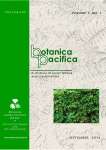
Scapania and Macrodiplophyllum in the Russian Far East
Choi Seung Se, Bakalin Vadim A., Sun Byung-Yun
Статья научная
The genera Scapania and Macrodiplophyllum have been studied in the Russian Far East. Macrodiplophyllum is represented by three species that are known in this genus. Scapania includes 38 species that are distributed among 12 sections. Keys are provided for all taxa found in the Russian Far East. All species based on the Far Eastern material are illustrated. Some corrections have been made in respect to the infrageneric structure of Scapania. Specifically, section Brevicaules R. M. Schust. was united with section Apiculatae H. Buch, S. sphaerifera H. Buch was transferred to section Aequilobae Mьll. Frib., and accordingly, section Spheriferae Konstant. & Potemkin was synonymized with the latter. The understanding of the distributions of some species has been improved. S. parvidens Steph. was reevaluated at the species level. S. integerrima Steph., S. ligulata Steph. and S. ampliata Steph. are now excluded from the hepatic flora of Russia. Scapania magadanica S. S. Choi, Bakalin & B.-Y. Sun sp. nov. is described based on the combination of paroicous inflorescence, green to colorless two-celled gemmae, a rounded apex of the dorsal lobe, and a non-decurrent ventral lobe, all of which are not present in other taxa of the genus.
Бесплатно

A comparative look at bioclimatic zonation, vegetation types, tree taxa and species richness in Northeast Asia
Box Elgene O., Fujiwara Kazue
Статья научная
Northeast Asia includes the mainly temperate-deciduous and boreal forest areas of the Russian Far East, Manchuria, northern China, Korea, and northern Japan. In terms of global zonation, the region includes parts of the boreal, cool-temperate and typical-temperate zones, plus polar and the respective mountain belts. Zonation in Russia also recognizes sectoral subdivisions that represent the gradient from the ultra-continental interior to the maritime Pacific areas. Northeast Asia is compared herein with other regions of the Northern Hemisphere, within this zonal framework, in terms of bioclimatic conditions and zonation, vegetation types, main tree taxa, limiting mechanisms and ranges of taxa, and taxon richness. Northeast Asia has greater climatic extremes and climatic diversity, and species richness is generally seen as higher than in comparable areas of eastern North America and Europe. To some extent this results from the separation of Japan, Kamchatka, Sakhalin, and Korea from the East Asian mainland by the large marginal seas. Cool-temperate mixed forests seem strikingly similar in Northeast Asia and northeastern North America, although the extent of the former is truncated in some areas by the sudden appearance of permafrost. Some vegetation types of Northeast Asia are seen as more unique. Several research needs are identified by this cross-continental comparison, especially the need for more complete information on taxon ranges (including full range maps), a common zonation vocabulary, and better climate data. Consideration of the region as a whole also focuses attention on questions of just what really are different species and what factors limit them.
Бесплатно
readera.ru
Botanica Pacifica - a journal of plant science and conservation
2015. Vol. 4, no. 2 (November 2015). Special Issue: "Plant evolution at levels from molecular to ecosystem"DOI: 10.17581/bp.2015.042
EDITORIAL PAPER
Sophia BarinovaHow Valentin Krassilov’s Ideas Determined the Development of Evolutionary TheoryABSTRACT PDF Article first published online: 31 OCT 2015 | DOI: 10.17581/bp.2015.04220
OPINION PAPERS
Alexandr P. RasnitsynEpigenetic theory of evolution in briefABSTRACT PDF Article first published online: 11 AUG 2015 | DOI: 10.17581/bp.2015.04201
Alexander A. ProtasovThe Bouquet of Evolutionary Coherences: The Prospects of the System Theory of EvolutionABSTRACT PDF Article first published online: 21 OCT 2015 | DOI: 10.17581/bp.2015.04214
Sviatoslav R. Rybnikov, Zeev M. Frenkel, Valery M. Kirzhner & Abraham B. KorolComplex Dynamics of Multilocus Genetic Systems: A Revisit of Earlier Findings in Relation to Ecosystem EvolutionABSTRACT PDF Article first published online: 20 OCT 2015 | DOI: 10.17581/bp.2015.04212
REVIEW PAPERS
Gregory J. RetallackAcritarch Evidence for an Ediacaran Adaptive Radiation of FungiABSTRACT PDF Article first published online: 20 AUG 2015 | DOI: 10.17581/bp.2015.04203
Dmitry D. Sokoloff, Paula J. Rudall, Richard M. Bateman & Margarita V. RemizowaFunctional Aspects of the Origin and Subsequent Evolution of Cotyledons in Seed PlantsABSTRACT PDF Article first published online: 30 SEP 2015 | DOI: 10.17581/bp.2015.04208
Galina M. Palamar-Mordvintseva, Petro M. Tsarenko & Sophia BarinovaPhylogenesis, Origin and Kinship of the Charophytic AlgaeABSTRACT PDF Article first published online: 24 OCT 2015 | DOI: 10.17581/bp.2015.04216
Natalia E. ZavialovaEvolutionary Transformations of Sporoderm Ultrastructure in Certain Monophyletic Lineages of Higher PlantsABSTRACT PDF Article first published online: 20 OCT 2015 | DOI: 10.17581/bp.2015.04213
Eugenia V. Bugdaeva, Elena B. Volynets, Valentina S. MarkevichThe Early Cretaceous Flora of Razdol’naya River Basin (Primorye Region, the Russian Far East)ABSTRACT PDF Article first published online: 28 OCT 2015 | DOI: 10.17581/bp.2015.04221
RESEARCH PAPERS
Vartika Singh & Neelu SinghStudy of Entrained Antarctic Diatoms from the Southwest Indian OceanABSTRACT PDF Article first published online: 25 SEP 2015 | DOI: 10.17581/bp.2015.04204
Yi Zhang, Jia-Jia WangHistorical Distribution of Metasequoia Referenced to Paleoclimate FactorsABSTRACT PDF Article first published online: 31 OCT 2015 | DOI: 10.17581/bp.2015.04219
Dina Mukha, Boris Ostretsov, Dzmitry Mukha & Leonid BrodskyStomatal Movement and Stomatal Formation Mechanisms Utilize the Same Regulatory GenesABSTRACT PDF Article first published online: 26 SEP 2015 | DOI: 10.17581/bp.2015.04207
Natalia P. Maslova & Alexei B. HermanApproach to Identification of Fossil Angiosperm Leaves: Applicability and Significance of Krassilov’s Morphological SystemABSTRACT PDF Article first published online: 25 SEP 2015 | DOI: 10.17581/bp.2015.04205
Eckart SchrankVariability and Morphology of Some Pteridophytic Spores from the Early Cretaceous (Albian) of the Negev, IsraelABSTRACT PDF Article first published online: 26 SEP 2015 | DOI: 10.17581/bp.2015.04206
Maria V. TeklevaBisaccate Pollen of Probable Gnetalean Species and Pollen Diversity in GnetophytesABSTRACT PDF Article first published online: 20 OCT 2015 | DOI: 10.17581/bp.2015.04211
Christopher J. Cleal & Mihai E. PopaPosition of Ovule Attachment in a Carboniferous Medullosalean PteridospermABSTRACT PDF Article first published online: 17 OCT 2015 | DOI: 10.17581/bp.2015.04209
Evgeny KarasevOn Small Pinnate Leaves of Peltasperm Pteridosperms from the Early Triassic of the Kuznetsk Basin (Mal’tsevo Formation, Babii Kamen Locality)ABSTRACT PDF Article first published online: 25 OCT 2015 | DOI: 10.17581/bp.2015.04217
TAXONOMIC NOVELTIES
Christian Pott, Wang Xiaoli & Zheng XiaotingWielandiella villosa comb. nov. from the Middle Jurassic of Daohugou, China: More Evidence for Divaricate Plant Architecture in WilliamsoniceaeABSTRACT PDF Article first published online: 23 OCT 2015 | DOI: 10.17581/bp.2015.04215
Chunlin Sun, Hongshan Wang, David L. Dilcher, Tao Li, Yunfeng Li, Yuling NaA New Species of Czekanowskia (Czekanowskiales) from the Middle Jurassic of Ordos Basin, ChinaABSTRACT PDF Article first published online: 17 OCT 2015 | DOI: 10.17581/bp.2015.04210
Boris I. PavlyutkinA New Species of Lonicera (Caprifoliaceae) from the Miocene of Primorye Region (the Russian Far East)ABSTRACT PDF Article first published online: 26 OCT 2015 | DOI: 10.17581/bp.2015.04218
IN MEMORIAM
Valentin Abramovich Krassilov: 1937-2015ABSTRACT PDF Article first published online: 20 MAY 2015 | DOI: 10.17581/bp.2015.04222
www.geobotanica.ru
Статьи журнала Botanica Pacifica: a journal of plant science and conservation (@geobotanica)

A comparative look at bioclimatic zonation, vegetation types, tree taxa and species richness in Northeast Asia
Box Elgene O., Fujiwara Kazue
Статья научная
Northeast Asia includes the mainly temperate-deciduous and boreal forest areas of the Russian Far East, Manchuria, northern China, Korea, and northern Japan. In terms of global zonation, the region includes parts of the boreal, cool-temperate and typical-temperate zones, plus polar and the respective mountain belts. Zonation in Russia also recognizes sectoral subdivisions that represent the gradient from the ultra-continental interior to the maritime Pacific areas. Northeast Asia is compared herein with other regions of the Northern Hemisphere, within this zonal framework, in terms of bioclimatic conditions and zonation, vegetation types, main tree taxa, limiting mechanisms and ranges of taxa, and taxon richness. Northeast Asia has greater climatic extremes and climatic diversity, and species richness is generally seen as higher than in comparable areas of eastern North America and Europe. To some extent this results from the separation of Japan, Kamchatka, Sakhalin, and Korea from the East Asian mainland by the large marginal seas. Cool-temperate mixed forests seem strikingly similar in Northeast Asia and northeastern North America, although the extent of the former is truncated in some areas by the sudden appearance of permafrost. Some vegetation types of Northeast Asia are seen as more unique. Several research needs are identified by this cross-continental comparison, especially the need for more complete information on taxon ranges (including full range maps), a common zonation vocabulary, and better climate data. Consideration of the region as a whole also focuses attention on questions of just what really are different species and what factors limit them.
Бесплатно
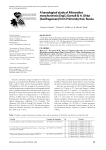
A karyological study of Micranthes manchuriensis (Engl.) Gornall & H. Ohba (Saxifragaceae) from Primorsky krai, Russia
Fukuda Tomoko, Koldaeva Marina N., Ikeda Hiroshi
Статья научная
Fukuda T., Koldaeva MN, Ikeda H. Karyological study Micranthes manchuriensis (Engl.) Gornall & H. Ohba (Saxifragaceae) from the Primorye Territory, Russia. Karyological study of Micranthes manchuriensis (Engl.) Gornall & H. Ohba (Saxifragaceae) from the Primorye Territory, Russia showed that the number of chromosomes in the investigated plants is 2n = 30. The maniocuriensis karyogram is described by the formula 13 m + 2 sm, with one pair of satellite chromosomes .
Бесплатно
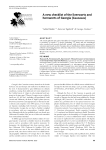
A new checklist of the liverworts and hornworts of Georgia (Caucasus)
Bakalin Vadim A., Tigishvili Ketevan, Arutinov George
Статья научная
Bakalin V., Tigishvili K., Arutyunov G. New checklist of liverworts and anthocerotian Georgia (Caucasus). A checklist of liverworts and anthocerotian Georgia, including 172 species (including 171 aboriginal species and 1 incidentally introduced, and now probably "fallen out" of the flora) was compiled. Each species is annotated with information on distribution within the administrative units of Georgia, references to the work in which this species was given for the country and the availability of samples from the territory of Georgia in the TBI and VBGI herbaria.
Бесплатно

A new large-celled species of Plagiochila (Plagiochilaceae, Hepaticae) from the southern flank of the Russian Far East
Bakalin Vadim A., Vilnet Anna A.
Статья научная
Bakalin VA, Vilnet AA A new large-celled species of Plagiochila (Plagiochilaceae, Hepaticae) from the southern edge of the Russian Far East. A new species of Plagiochila is described from the Ussuri taiga, located in the south of the Russian Far East. Plagiochila sichotensis Bakalin et Vilnet sp. nov. (sect.Plagiochila) is characterized by whole leaves, relatively small in size and, in particular, large leaf cells reaching in the middle of the leaf 40-60 microns in width. The last feature distinguishes the new species from all known taxa of the genus and is close to the values observed in the evolutionarily unrelated genus Mylia. Apparently, this epixial taxon is limited in the distribution of the lower and middle high-altitude belts of the Sikhote-Alin mountains. Description, illustrations and distinctive features of the new species are given.
Бесплатно
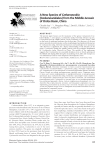
A new species of Czekanowskia (Czekanowskiales) from the Middle Jurassic of Ordos basin, China
Sun Chunlin, Wang Hongshan, Dilcher David L., Li Tao, Li Yunfeng, Na Yuling
Статья научная
Sun Ch., Wang H., Dilcher DL, Lee T., Lee Yu., In the south. A new species of Czekanowskia (Czekanowskiales) from the Middle Jurassic deposits of the Ordos basin, China. The article focuses on the taxonomy of the genus Czekanowskia (Czekanowskiales). A new species, Czekanowskia (subg. Harrisella) ordosensis sp. nov., is first described from the Middle Jurassic deposits of the Yan'an formation of the Ordos basin, China, on the basis of epidermal leaf structures. The discovery of a new species gives new information on the morphological and epidermal features of the genus Czekanowskia (subg. Harrisella) and extends our knowledge of its taxonomy. This find is of great importance for understanding the diversity of the genus Czekanowskia during the Middle Jurassic period and its distribution in geological time in China. An analysis of tafocenosis shows that Czekanowskia was represented by seasonally deciduous trees or shrubs growing on mountain slopes and gently sloping areas along river valleys, along shores of lakes and marshes in extensive sedimentary basins in warm-temperate and temperate zones.
Бесплатно
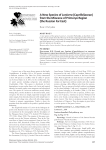
A new species of Lonicera (Caprifoliaceae) from the Miocene of Primorye region (the Russian Far East)
Pavlyutkin Boris I.
Статья научная
Pavlyutkin BI A new species of Lonicera (Caprofoliaceae) from the Miocene of Primorsky Krai (Russian Far East). Brief information about the current and fossil species of Lonicera is given, a systematic list of the local Miocene flora of the Gora Prominent (Primorye), consisting of 41 species from 30 genera and 20 families, is given. A new species of the genus Lonicera (Lonicera krassilovii Pavlyutkin) is described.
Бесплатно
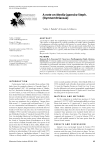
A note on Nardia japonica Steph. (Gymnomitriaceae)
Bakalin V.A., Klimova K.G.
Статья научная
Bakalin VA, Klimova K.G. Note about Nardia japonica Steph. (Gymnomitriaceae). The morphological concept of Nardia japonica is specified. This species is characterized by coarse-grained oily bodies, which contradicts the indications of homogeneous oil bodies attributed to this species by a number of authors. Plants with homogeneous oil bodies belong to a new, previously not described Nardia pacifica Bakalin sp. nov. The report of N. lescurii from Japan is obviously based on the erroneous definition of N. japonica, while N. lescurii is endemic to the Appalachians.
Бесплатно

A revision of Lepidoziaceae (Hepaticae) in the Russian Far East I. Bazzania
Bakalin Vadim A.
Статья научная
Bakalin V.A. Revision of Lepidoziaceae (Hepaticae) for the Russian Far East I. Bazzania. The genus Bazzania is audited for the Russian Far East. There are 5 species. Two species (B. bidentula and B. japonica) are excluded from the flora. Two species (B. parabidentula and B. manczurica) are described as new to science. The distribution of species within the studied region is substantially specified. Descriptions and illustrations on the studied regional materials and sample samples are made. The article includes a list of samples studied (from the Russian Far East and adjacent regions) and a key for identifying species recognized in this territory.
Бесплатно

A topography-based model of the vegetation cover of the Lanzhinskie mountains
Omelko Alexander M., Krestov Pavel V., Yakovleva Anna N.
Статья научная
By means of the GAM technique it is possible to create detailed maps of the potential vegetation for regions that are difficult to access. This is particularly important for wide mountain areas of Northeast Asia, where such maps have never been created. High-resolution DEMs permit increased prediction accuracy and modeling of complex vegetation patterns. Most vegetation types in the area are controlled mainly by the moisture regime and by regimes of sediment transport and accumulation. The relatively small amounts of rainfall in the continental climate are distributed spatially by relief elements. This creates a wide range of soil moisture regimes: from very dry, with a prolonged period of moisture deficit, to wet, without moisture deficit during the growing season at all. Therefore, moisture appears to be a critical resource in this climatic region, and it is a main differentiating factor for the vegetation. The map of potential vegetation, obtained satisfactorily, reflects altitudinal zonation and inter-zonal patterns of vegetation distribution. The area occupied by some vegetation communities is overestimated, however, due mainly to insufficient DEM resolution.
Бесплатно
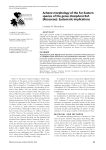
Achene morphology of the far eastern species of the genus Dasiphora Raf. (Rosaceae): systematic implications
Pshennikova Lyudmila M.
Статья научная
Pshennikova LM Morphology of nuts of Far Eastern species of the genus Dasiphora Rafin (Rosaceae): systematic significance. The results of morphological studies of the nuts of five taxa of the Far Eastern representatives of the genus Dasiphora are presented. It is shown that the taxon D. davurica var. flava by the size of the nuts and their pubescence is significantly different from other Far Eastern representatives of the genus. The data obtained indicate the need to give a variety of D. davurica var. flava view status. A new nomenclatural combination of Dasiphora flava (Vorosch.) Gorovoj, Pshenn. et S. Volkova.
Бесплатно
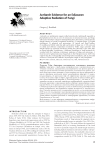
Acritarch evidence for an Ediacaran adaptive radiation of fungi
Retallack Gregory J.
Статья научная
Retallak G.J. Akritarchs confirm the adaptive radiation of fungi. Acritarchs - problem microfossils with organic clastic walls, are traditionally considered as phytoplankton, as well as cysts of multicellular organisms, mesomycetes and fungi. This review suggests criteria for distinguishing these groups of organisms and analysis of the characteristics of several groups of Precambrian acritars: (1) irregular form, (2) fixation of hyphae (3) spherical projections of cell walls, (4) whole hyphae and hyphae with septa 5) multilayered brittle and stratified coverings (6) large (> 100 μm) and (7) chitin and chitosan content detected by infrared spectroscopy. Large acritarchs with signs of fungi are common and diverse in the Ediacaran biota, while lichen-like organisms are few in number. Communities of small acritars reached the greatest diversity during the Cambrian evolutionary explosion of algae and multicellular. Findings of glomeromycete fossils up to Paleoproterozoic (2,200 million years) support the idea of extending life on land in the form of fungi long before terrestrial plants and speak in favor of the version of the origin of early terrestrial plants from mycotrophic organisms, according to Pirozinsky and Malloch.
Бесплатно
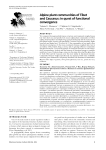
Alpine plant communities of Tibet and Caucasus: in quest of functional convergence
Elumeeva Tatiana G., Onipchenko Vladimir G., Rovnaia Elena N., Wu Yan, Werger Marinus J. A.
Статья научная
Elumeeva TG, Onipchenko VG, Rovnaya EN, Wu Yan, Werger M.JA. Alpine Phytocenoses of Tibet and the Caucasus: in Search of Functional Similarity We compared the structure of the aboveground phytomass and the biomass-weighted features of the leaves (leaf area and specific leaf surface) in the alpine communities of Tibet (alpine shrub meadows and alpine bogs with and without grazing) and Caucasus (alpine lichen heathlands, motley-sown meadows, geranium-kopeechnikovye meadows, alpine carpets and alpine bogs). We checked whether 1) there are features of functional similarity between communities; 2) whether the weighted average signs of leaves vary depending on the position of the community in the catena; 3) grazing affects the functional structure of communities. In order to reveal regularities in the structure of communities, we carried out an analysis of the correspondence with the remote trend with the biomass of plants belonging to different functional groups, as dependent variables, and the sites as independent variables. The position of the community in the catena was the leading factor, and the alpine swamps of Tibet and the Caucasus turned out to be the most similar in terms of functional structure. The weighted average specific leaf surface increased with increasing humidity of the habitat and communities with the dominance of cereals to communities with a predominance of motley grass and frequent disturbances.
Бесплатно

An approach for mapping Northern Fennoscandian forests at different scales
Chernenkova Tatiana V., Puzachenko Mikhail Yu., Morozova Olga V., Ogureeva Galina N., Kuperman Roman G.
Статья научная
Chernenkova TV, Puzachenko M.Yu., Morozova OV, Ogureeva GN, Kuperman R.G. An approach to mapping the forests of northern Fennoscandia on different scales. Assessing forest diversity over its range is a major problem that requires considerable effort to collect and analyze heterogeneous material. An approach is presented for mapping and assessing the current spatial diversity of forests in the European part of Russia at various scales. It is based on a multi-parameter analysis of the characteristics of plant communities obtained from ground-based surveys, remote sensing data (DSD), and morphometric parameters of the relief. The main stages of our methodology are: a) ground-based studies in the test area in accordance with the main zonal subdivisions of the forest cover, b) development of a unified forest classification, c) mapping at the local level on a large scale, d) mapping at the regional level on a small scale. The forest classification is based on the consideration of ecological and morphological groups of plant species in the syntaxon and includes seven hierarchical units: vegetation type, vegetation subtype, formation class, formation, association class, association group and association. As an example, there are two types of maps of forest cover for local and regional level in the northern part of Fennoscandia.
Бесплатно

An electronic management system for a digital herbarium: development and future prospects
Kislov Dmitry E., Bakalin Vadim A., Pimenova Elena A., Verkholat Valentina P., Krestov Pavel V.
Статья научная
Kislov DE, Bakalin VA, Pimenova EA, Verkholat VP, Krestov P.V. Electronic herbarium control system: development and development prospects. The structure and functional aspects of the electronic herbarium control system developed at the Botanical Garden-Institute of Far Eastern Branch of the Russian Academy of Sciences (BSI) in 2016-2017 are considered. The purpose of the system is to provide online access to herbarium data, including basic operations of searching and entering records in herbarium database, as well as creating breadboard models of herb samples. Thus, the electronic herbarium control system is a multi-purpose program complex. It is written primarily in Python programming language and has the following capabilities: two-stage control of digitized herbarium samples, support of simultaneous operation of several users and management of several herbariums with different acronyms, semi-automatic sample labeling subsystem, as well as the ability to enter information about multi- , spore), flexible search and filtering of its results, including geographic areas, using both a web-interface, t and search for opportunities based HTTP API. This system is used to control the electronic herbarium in BSI, including its Sakhalin and Amur branches. The system can also be used to integrate herbarium information from collections of other institutions.
Бесплатно
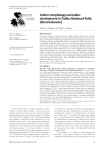
Anther morphology and pollen development in Trollius ledebourii Rchb. (Ranunculaceae)
Buglova Liubov V., Vasiljeva Olga Y.
Статья научная
Buglova LV, Vasilyeva O.Yu. Anther structure and pollen development in Trollius ledebourii Rchb. (Ranunculaceae). The article describes the structure of anthers and tapetums, meiosis of pollen parent cells, postmeotic development of pollen and its anomalies in Trollius ledebourii Rchb. (Ranunculaceae). Cell layers develop centripetally; meiosis is synchronous within microsporangia, but it is considerably stretched within a single flower. The development of the cell wall is simultaneous. It was found that the type and frequency of anomalies depend on the position of the stamens on the spiral of the flower-bud. Anomalies in the functioning of the fission spindle, leading to the formation of tetrads with a different set of chromosomes, as well as apoptosis were recorded only in the first row of anthers. These phenomena can lead to 100% sterility of the pollen. The registration of fertility and viability of pollen is carried out, the procedure for estimating pollen losses is proposed. We first discovered in the family Ranunculaceae the shift of some part of the archesporal cells to a sterile development with the formation of cells similar to tapetum, but larger and with a smaller period of existence. They are identified as trabeculae and can serve as an additional food for meiocytes.
Бесплатно

Anti-lipoxygenase, radical scavenging and antimicrobial activities of lichen species of genus Heterodermia (Physciaceae)
Behera Bhaskar C., Morey Mangesh V., Gaikwad Subhash B.
Статья научная
Becher BS, Mori MV, Gaykvad SB Antilipoxygenase, radical purification and antimicrobial activity of lichens of the genus Heterodermia (Physciaceae). The aim of the study was antilipoxygenase, radical purification and antimicrobial activity of the ethyl acetate extract of lichen species of the genus Heterodermia (Physciaceae). Extracts of species of the genus are characterized by lipoxygenase inhibition (LOX), depending on the concentration. Fifty percent (IC50) inhibition of LOX was observed in H. diademata, H. flabellata, H. antillarum and H. incana species at concentrations of 0.123 0.153, 0.160 and 0.150 mg / ml, respectively; which is less than the synthetic antioxidants BHA and BHT. Only the extract of H. diademata showed IC50 at a concentration of 0.123 mg / ml equal to the LOX inhibitor indomethacin. The kinetics of LOX inhibition of extracts of different lichen species shows a different inhibition regime. Competitive inhibition of LOX was observed in H. albicans and H. antillarum; uncompetitive - in H. diademata; The absence of competition is characteristic of H. angustiloba, H. flabellata, H. incana, H. isidiophora and H. pseudospeciosa. Extracts of these species also showed a fifty percent activity of radical purification. Ethylacetate extracts of H. diademata, H. angustiloba, H. albicans, and H. isidiophora showed strong antimicrobial activity against most of the tested microorganisms at concentrations ranging from 0.232 to 0.591 mg / ml. The results show that the species of lichen Heterodermia can be used as a new bioresource of natural lipoxygenase with antimicrobial and purifying properties.
Бесплатно

Approach to identification of fossil angiosperm leaves: applicability and significance of Krassilov’s morphological system
Maslova Natalia P., Herman Alexei B.
Статья научная
Maslova NP, German A.B. An approach to determining the leaves of fossilized angiosperms: the applicability and significance of the Krasilov morphological system. The recent results of the study of Cretaceous platanoid leaves suggest that the morphological classification of leaves suggested by Krasilov is the most suitable for the determination of fossil (Cretaceous and Tertiary) dispersed leaves of angiosperms. This classification is independent of the system of modern plants.
Бесплатно
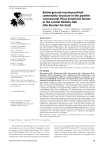
Below-ground ectomycorrhizal community structure in the postfire successional Pinus koraiensis forests in the Central Sikhote-Alin (the Russian Far East)
Malysheva Ekaterina F., Malysheva Vera F., Kovalenko Alexander E., Pimenova Elena A., Gromyko Michael N., Bondarchuk Svetlana N., Voronina Elena Yu.
Статья научная
Malysheva EF, Malysheva VF, Kovalenko AE, Pimenova EA, Gromyko MN, Bondarchuk SN, Voronina E.Yu. Structure of communities of ectomycorrhizal fungi in the soil of cedar forests of different stages of post-fire succession in Central Sikhote-Alin (Russian Far East). The aim of the study was to study the effect of fire on the degree of ectomycorrhizal (EM) colonization of Pinus koraiensis roots. Identification of the EM component was made directly from mycorrhizal endings using molecular methods. Communities of EM fungi, associated with the roots of P. koraiensis, were very diverse. A total of 110 operational taxonomic units (OTE) were found. The predominant in the number of species families in all studied communities, including control, were Russulaceae and Thelephoraceae. The richest in species distribution were Tomentella, Russula, Piloderma, Inocybe, Suillus, Sebacina and Lactarius. It was found that the degree of mycorrhizal colonization of seedlings in the communities exposed to the fire and in the unburned areas was high. The difference between the studied communities in the taxonomic composition and in the composition of the dominant species of EM symbionts, which form the mycorrhizal connection with the seedlings, was revealed. The vertical distribution of the mycelium of EM fungi in the soil horizons was estimated. It is shown that this distribution appears more aligned in undisturbed forests and at later stages of succession. The results of the study show that EM fungi play an important role in the processes of regeneration of natural stands after fires.
Бесплатно

Biodiversity of rain-barrier forest ecosystems of the Sayan mountains
Nazimova Dina I., Danilina Dilshad M., Stepanov Nikolay V.
Статья научная
Nazimova DI, Danilina DM, Stepanov NV Biodiversity of the Sayan barrier-rain forest ecosystems Mixed coniferous and coniferous-broadleaved forests with a high-grass cover, dominated by Abies sibirica, Pinus sibirica and Populus tremula, known in Russia as the black forests, represent a special class of subboreal (hemiboreal) ecosystems of the Altai-Sayan Ecoregion. Their structure is not typical for the boreal Siberian taiga and, with some features, resembles the subnemoral dark coniferous forests of the Far East. Recent researches of the authors confirm the relict and original nature of the black forests and their sinus structure, as well as ancient floral connections with mixed dark coniferous-broad-leaved forests of the Far East. On the other hand, with generalized classification, the black forests can be attributed to the unique orobium of barrier rain forests, which is represented only in the excessively humid (pergumid) bioclimatic provinces of the mountains of Southern Siberia and is composed of a spectrum of high-belt complexes: black mixed and dark coniferous forests, dark coniferous taiga, subalpine dark coniferous forests and light forests. These plant units are important for bioclimatic classification and mapping of mountain vegetation and mountain ecosystems.
Бесплатно
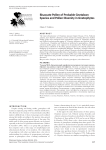
Bisaccate pollen of probable Gnetalean species and pollen diversity in gnetophytes
Tekleva Maria V.
Статья научная
Tekleva M.V. A two-mesh morphotype of possible tyrannical and a variety of pollen grains of gnathophytes. The ultrastructure of exin Dinophyton spinosum (Upper Triassic, USA), Preflosella nathania and Alisporites alimentosus (Lower Chalk, Russia) has been studied. Pollen grains of Dinophyton spinosum and Preflosella nathania were extracted from the corresponding reproductive organs; The pollen grains of Alisporites alimentosus are extracted from a fossil insect stomach impression. Dinophyton and Preflosella are classified as gynthophytes. It was assumed that the pollen grains of Alisporites alimentosus were produced by Preflosella. These three species are characterized by a cellular infratextum, however, the nature of the honeycomb and the thickness of the layers differ significantly in these species. Thus, it was shown that the pollen grains of Alisporites alimentosus could not be produced by Preflosella nathania. Two-mesh cellular pollen grains of Dinophyton and Preflosella differ from the rest of the known pollen types of gnathophytes (bezmeshkovye, with a granular or columnar infractectum). Pollen types of gynthophytes are also found in other groups of plants; Comparison and possible transitions between pollen types of gnathophytes are considered.
Бесплатно
readera.ru




